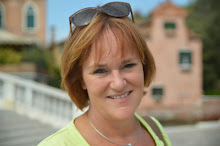- firm white drawing paper
- ruler
- pencil
- color marers
- waterproof black marker
- salad oil
- brush
- paper towels
Theo van Doesburg (1883-1931) was a Dutch painter, architect and writer. He was charmed by the abstract art of Kandinsky and Picasso's cubistic work. In 1917 he founded the magazine De Stijl, in which he and other artists could publish their innovative ideas about art. Famous Dutch artists who belong to the Stijl are Piet Mondriaan, Bart van der Leck and Gerrit Rietveld.
Theo van Doesburg, abstraction of a cow (1918)
Van Doesburg also designed stained glass windows. Abstract art thus became a functional part of a building.
For this lesson I used his stained glass window Composition VIII. It was designed as an upper window for the front doors of houses built in 1918 in Rotterdam. During the restoration of the houses in 1989, the windows were removed and a number of them were purchased by museums.
Composition VIII
Discuss what stands out:
- only rectangles and squares
- rectangles can stand or lie
- maximum 3 colors plus white
- never two of the same colors next to each other
- black outlines
- a long horizontal line through the center
What should you do?
Step 1
Use a ruler and pencil to draw a horizontal line through the center of the drawing sheet. Then draw rectangles and squares. Measure carefully to be sure your shapes are really symmetrical.
Step 2
Choose 3 colors of markers and color the shapes. You can use white too, by leaving shapes white. No two of the same colors next to each other. Trace the dividing lines with black permanent marker; use a ruler! Draw thickenings at the intersections of the lines, just like in stained glass windows.















